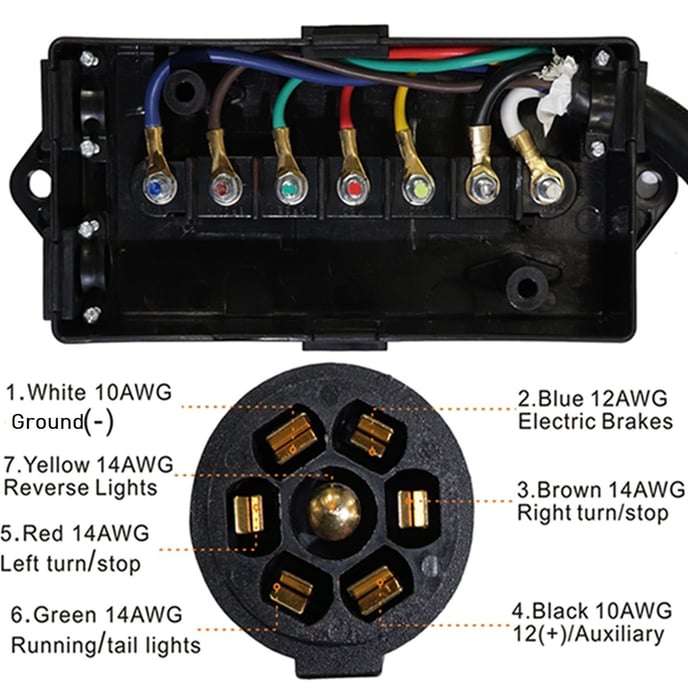On the "7 Pin" Trailer Wiring System
Common questions and clarification on the use of the 7 pin wiring and box.
OGT gets a lot of questions about the 7 pin wiring! Our system is generic and industry standard. The 7 pin plug should work with the trailer harness plug on all vehicles - if you have issues, contact your vehicle manufacturer with the dimensions of our plug and they will be able to help you.
Here is an image of the plug and of the box, showing the function of each pin:

All of our lights on the trailer are LED, and the grounds come all the way back to this box for every run.
Connecting the Auxiliary power pin to the trailer battery bank
Do not hook up trickle charging with lithium batteries unless you install a DC to DC charger or some method of regulating the current and voltage. Lithium battery voltages are slightly higher and will back feed power to the vehicle, which will cause the trailer to only be charged to about 80-90% when you arrive at your camp site. Additionally, lithium batteries have very low internal resistance (<10mΩ) which allows for much higher current draws. Connecting low or dead lithium batteries directly to the vehicle's 7-pin system can cause a rush of current in excess of 100 amps; a voltage difference of 2 volts between the trailer and vehicle batteries could cause 200 amps to flow through the wiring!
The 10 AWG auxiliary power pin, the black wire, is intended to charge the battery in the emergency break away box for the electric brake system. It is already connected for this.
It is recommended to fully charge the batteries in the trailer prior to hooking up a trickle charge wire. Since this wire is not specifically intended for this purpose, has a long run, and the vehicle side of the wiring is unknown (circuit breakers, gauge, capacity,) the charging of the trailer batteries via this method is best considered trickle or maintenance. If your batteries are discharged to under 12.5 volts they should be charged by a DC to DC charger, an AC to DC charger (equipped on trailer already) a solar panel system with a charge controller, or by other means.
A 30 amp inline fuse must be installed between the aux pin and the trailer batteries if not done so at the factory. A 30 amp breaker/switch can be installed inline between the 7 pin aux power pin and the trailer battery system. The fuse will protect the circuit and the switch/breaker.
Grounding is equally important as the current supply. The connection from the ground pin in the 7 pin box to the trailer battery bank should be checked and improved if necessary. You can run a 10 gauge lead from the white pin in the 7 pin box to the ground bus on the BlueSea fuse panel, or to the ground post of one of the 12V batteries. With the only connection between the vehicle and the trailer being the 7 pin connector (i.e. with the trailer disconnected and with the chains not in contact) continuity should be confirmed between the ground pin in the 7 pin box and the trailer's frame. If there is a high resistance here, it is recommended that a minimum 10 AWG ground wire is run from the ground pin in the 7 pin box to the trailer frame.
All of these modifications must be vetted by the customer or their chosen installer and are not the responsibility of OGT!
If you decide to hook up this trickle charging wire, make sure to unplug the trailer from the vehicle when you get to your camp site or you may end up stranded with a dead vehicle battery. The trailer will also use the power stored in the emergency brake battery, it is recommended to install a switch for the trickle charging wire or pull the fuse for the trickle charging out to prevent draining the emergency brake battery and don't hook up a dead trailer to your vehicle.
Be careful, and have fun out there!
The OGT Team
![OGT logo-2.png]](https://support.offgridtrailers.com/hs-fs/hubfs/OGT%20logo-2.png?height=50&name=OGT%20logo-2.png)